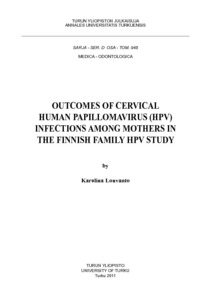Outcomes of cervical human papillomavirus (HPV) infections among mothers in the Finnish Family HPV Study
Louvanto, Karolina (2011-02-25)
Outcomes of cervical human papillomavirus (HPV) infections among mothers in the Finnish Family HPV Study
Louvanto, Karolina
(25.02.2011)
Annales Universitatis Turkuensis D 948 Turun yliopisto
Julkaisun pysyvä osoite on:
https://urn.fi/URN:ISBN:978-951-29-4534-4
https://urn.fi/URN:ISBN:978-951-29-4534-4
Kuvaus
Siirretty Doriasta
ei tietoa saavutettavuudesta
ei tietoa saavutettavuudesta
Tiivistelmä
To understand the natural history of cervical human papillomavirus (HPV)-infections, more information is needed on their genotype-specific prevalence, acquisition, clearance, persistence and progression.
This thesis is part of the prospective Finnish Family HPV study. 329 pregnant women (mean age 25.5 years) were recruited during the third trimester of pregnancy and were followed up for 6 years. The outcomes of cervical HPV infections were evaluated among all the mothers participating in the study. Generalized estimating equation (GEE)-models and Poisson regression were used to estimate the risk factors of type-specific acquisition, clearance, persistence and progression of Species 7 and 9 HPV-genotypes.
Independent protective factors against incident infections were higher number of life-time sexual partners, initiation of oral contraceptive use after age 20 years and becoming pregnant during FU. Older age and negative oral HR-HPV DNA status at baseline were associated with increased clearance, whereas higher number of current sexual partners decreased the probability of clearance. Early onset of smoking, practicing oral sex and older age increased the risk of type-specific persistence, while key predictors of CIN/SIL were persistent HR-HPV, abnormal Pap smear and new sexual partners.
HPV16, together with multiple-type infections were the most frequent incident genotypes, most likely to remain persistent and least likely to clear. Collectively, LR-HPV types showed shorter incidence and clearance times than HR-HPV types. In multivariate models, different predictors were associated with these main viral outcomes, and there is some tentative evidence to suggest that oral mucosa might play a role in controlling some of these outcomes.
This thesis is part of the prospective Finnish Family HPV study. 329 pregnant women (mean age 25.5 years) were recruited during the third trimester of pregnancy and were followed up for 6 years. The outcomes of cervical HPV infections were evaluated among all the mothers participating in the study. Generalized estimating equation (GEE)-models and Poisson regression were used to estimate the risk factors of type-specific acquisition, clearance, persistence and progression of Species 7 and 9 HPV-genotypes.
Independent protective factors against incident infections were higher number of life-time sexual partners, initiation of oral contraceptive use after age 20 years and becoming pregnant during FU. Older age and negative oral HR-HPV DNA status at baseline were associated with increased clearance, whereas higher number of current sexual partners decreased the probability of clearance. Early onset of smoking, practicing oral sex and older age increased the risk of type-specific persistence, while key predictors of CIN/SIL were persistent HR-HPV, abnormal Pap smear and new sexual partners.
HPV16, together with multiple-type infections were the most frequent incident genotypes, most likely to remain persistent and least likely to clear. Collectively, LR-HPV types showed shorter incidence and clearance times than HR-HPV types. In multivariate models, different predictors were associated with these main viral outcomes, and there is some tentative evidence to suggest that oral mucosa might play a role in controlling some of these outcomes.
Kokoelmat
- Väitöskirjat [3059]
